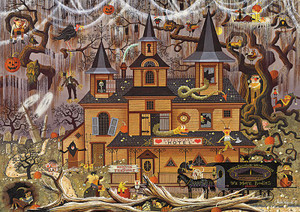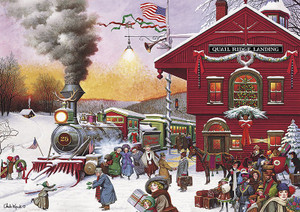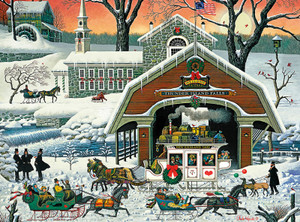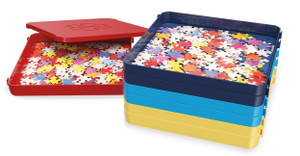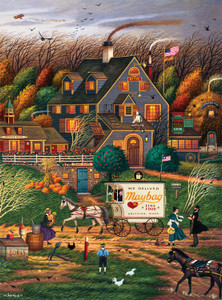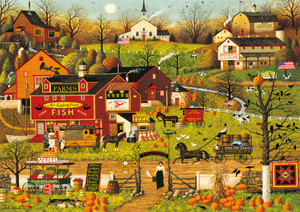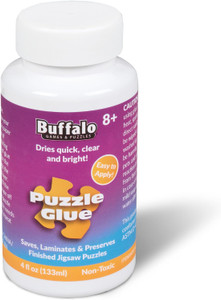Posted by Buffalo Games on Apr 6th 2022
How Long Does It Take to Do a 2,000-Piece Jigsaw Puzzle?
Back in the early 1760s, a mapmaker in London had an idea. He pasted a map of Europe onto a thin piece of wood and used a scroll saw to cut it into pieces. Each country was its little piece. The mapmaker’s name was John Spilsbury, and he marketed his cut-up wooden maps to the affluent as tools to teach children geography.
It wasn’t long until these new jigsaw puzzles expanded beyond being learning tools, and they soon began depicting fairytale subjects, trains and ships, and nursery rhymes. In the early 1900s, a company called Parker Brothers came up with the idea of interlocking pieces with each one cut by hand.
During the Great Depression, the popularity of these puzzles exploded because so many people bought them and because so many people made them. Anyone could buy a little saw, set up a workspace in their homes, and start making puzzles.
And that’s precisely what they did.
They began making puzzles, selling them to neighbors, and renting them out through local drug stores, which became the first “puzzles stores.” Today, puzzles depict many scenes and characters, and they can also be personalized.
Whether you’ve been putting jigsaw puzzles together for decades or are ready to try your hand at one for the first time, it’s always an excellent time for puzzles.
Choosing Your Puzzle: How Long Does a 2,000-Piece Puzzle Take?
Many factors will determine how long jigsaw puzzles for adults take to complete. These include:
- How many pieces there are
- How large or small the pieces are
- The shapes of the pieces
- The pattern designs on the pieces
- Your experience with jigsaw puzzles
It’s a good idea to prepare and know what you’re getting into before you get started to make your experience as enjoyable as possible. As you might expect, 500-piece puzzles usually won’t take as long to put together as 1,000-piece puzzles.
On average, for 2,000-piece puzzles, a person might spend 15-20 hours before completing one. Many 1,000-piece puzzles take around 5-10 hours to complete, and 500-piece puzzles take 2-6 hours.
Picking Your Puzzle: Patterns, Pictures, and Designs
There are thousands of different puzzles for you to choose from. Some people enjoy puzzles that depict animals, while others like putting together ones that showcase their favorite cartoon, comic, TV, or movie characters.
Still, others enjoy puzzles with inspirational sayings, while some like vintage paintings of Americana scenes. More straightforward puzzles will have distinct patterns that make it easier to match up and connect puzzle pieces. In contrast, more challenging ones will have a much larger variety of colors and complex designs with many similar-looking pieces.
Remember: The more distinct the pieces are from each other, the easier it will be to discern which pieces go where to connect the patterns and designs you see.
Putting Together Everything from 100-Piece Puzzles to 2,000-Piece Puzzles
No matter how many pieces your jigsaw puzzle has, you may want to consider using some accessories to ramp up your experience. There are many excellent accessories on the market explicitly designed for jigsaw puzzles. A few of these are:
- A roll-up puzzle mat
- Puzzle adhesive
- Puzzle piece sorting trays
Make sure that the puzzle mat you get is black or white: it’s essential to have a mat that contrasts with your puzzle pieces to see every detail in each piece much more effortlessly.
The best puzzle adhesives are peel-and-stick backings. Avoid puzzle glue because it tends to make a sticky mess, you have to sit and wait for it to dry, and it doesn’t always hold pieces together very well.
Prepare to Puzzle
Preparing beforehand and taking a few simple steps before interlocking your first pieces can make a difference in the time it takes you to complete your puzzle.
It’s essential that you don’t get started before having everything set. This is especially true for your puzzle mat and your lighting. Overhead lights are best when working on jigsaw puzzles for adults, but a table lamp or desk lamp will do.
Floor lamps are not the best choices when doing puzzles because they tend to cast pretty heavy shadows on the pieces, making it much more difficult for you to see the patterns on them!
Tips for Completing 2,000-Piece Puzzles
In addition to getting your hands on sorting trays for your pieces, good lighting, and a roll-up black or white puzzle mat, you can take additional steps to make sure you have a great time with your puzzle with as little frustration as possible.
Your Workspace
Make sure that you leave enough room on all sides of the puzzle free; a few inches on each side will do. This helps prevent accidental falls to the floor and also helps keep your pieces together.
While some experts recommend that you not put loose pieces in the middle of the puzzle (instead, they say you should keep them in sorting trays or outside the puzzle), many people create a small collection of pieces in the center, anyway!
Your Attack Plan
Most people like to separate the edge pieces and start by assembling those first. This gives them a good starting point to build inward toward the middle.
Don’t spend tons of time hunting for specific pieces; move on to a different section if you get stuck. The elusive pieces will show up eventually, and before you know it, you’ll have a gorgeous completed 2,000-piece puzzle you’ll be proud of!





